Can I Feed My Ciclhids Catfood
Cichlids are a great fish for your collection due to their brilliant appearance and color combinations. But to rear a healthy fish, you should know how to feed your fish. So, this is the complete guide on how you correctly Feed Cichlids.
It is enough to feed the cichlids twice a day. Also, providing food in the morning and at night is better. Further, it would be best if you feed your cichlids daily. However, cichlids are very aggressive eaters. Therefore, you should highly consider the feeding amount and feeding frequency.
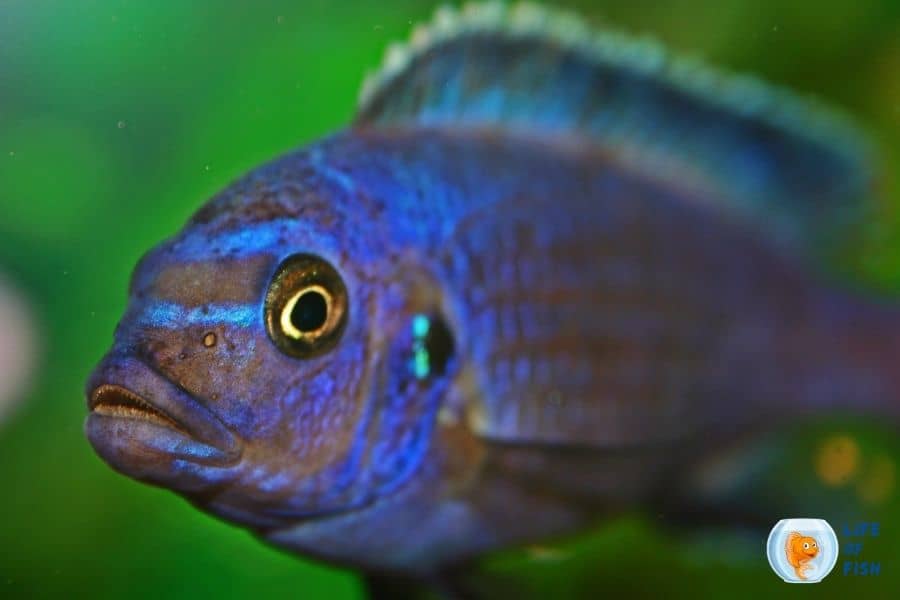
What To Feed Cichlids?
Above all, there are about 1870 varieties of cichlids scientifically described worldwide. Among them, 1300 varieties are South African cichlids, and 570 are Central American cichlids. Furthermore, this cichlid family consists of carnivores, herbivores, and omnivores. Therefore, cichlids' feed requirements depend on the type of fish that you own.
Carnivores cichlids in the wild
Basically, cichlids belong to the carnivore category like Jack Dempseys, Oscar, and Jaguar fish mainly accept animal food sources. Hence, it means they eat other fish, crustaceans, insects, or a combination of these foods. Generally, carnivore-type cichlids have a short digestive tract. It helps to break down the high protein and fat-rich food sources immediately.
Herbivores cichlids in the wild
Moreover, African cichlids like Mbuna and Tropheus feed only plant matter, and they graze throughout the day. Also, they primarily eat algae, live plants, and biofilm. The important thing is, that herbivore cichlids have a long intestinal tract. Thus, they can absorb the many nutrients from foods that contain low protein and fat.
Omnivores cichlids in the wild
Cichlid fish that belongs to the omnivore category feed both animal and plant sources. Moreover, if we consider the types of cichlids, most varieties are omnivores. For example, varieties of angelfish, peacocks, and fire mouths are omnivore fish. Further, these cichlids tend to eat anything that you provide them to eat.
Also, the length of the digestive of omnivore cichlids is between the track length of carnivores and herbivores. Further, this digestive tract breaks down a variety of foods.
After all, If you like to rear cichlids in your aquarium, you should know the foods they eat in the wild. That's why I try to give a rough idea about it above. Through this knowledge, you can select suitable foods for Cichlids in your tank.
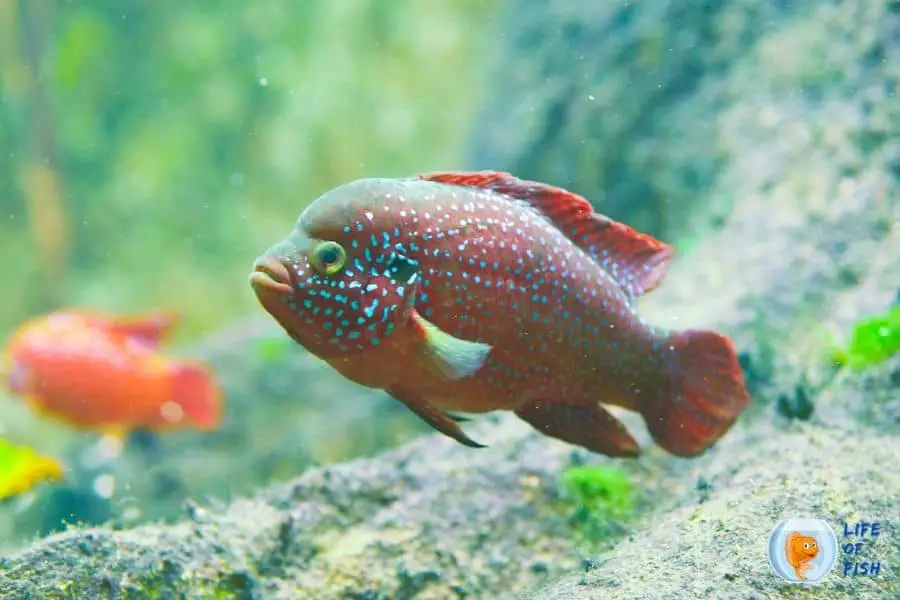
Cichlids Food list
In captivity, you can provide many foods to cichlid fish. But it would be best if you considered their food pattern. You can feed omnivore cichlids using any of the listed foods. Also, do not feed herbivores fish with meaty feeds and carnivore fish with plant matter.
- Small fish meat
- Insects
- Tubifex Worms
- Brine shrimps
- Cichlids pellets
- Omega one super color sinking cichlid pellets
- Hikari cichlid bio gold mini pellets
- New life spectrum cichlid 80g (naturox series)
- Northfin food cichlid formula 1 mm pellet
- Northfin veggie formula 1 mm 500 g
- Xtreme aquatic foods 2217- e cichlid peewee
- Cobalt aquatic ultra-cichlid pellets slow sinking
- Aetracichlid cichlid crisps advanced clear water formula
- Flake foods
- Zoo Med Spirulina 20 Flake Fish Food
- Ocean Nutrition Cichlid Flake Food
- Tetra Cichlid Flakes
- Frozen foods
- Fish wafers
- Some Household vegetables
- Cucumber
- Boiled carrot
- Zucchini
- Peas
- Lettuce and Spinach
- Household fruits
- Blueberry
- Strawberry
- Grapes
How Many Pellets To Feed Cichlids?
Evidently, you should provide the number of pellets that cichlid fish can finish within 2 or 3 minutes. Further, you should be highly concerned about the number of pellets that offer to your fish. The cichlids can overfeed quickly because they are aggressive feeders. Moreover, they do not have any idea about the amount they eat.
Firstly, you can provide a small number of pellets. Then if the fish finish these pellets before 3 minutes, you can add extra pellets.
But do not put a large number of pellets into the aquarium at once. It affects the health of the cichlids and the water quality of the tank.
How Often To Feed Cichlids With Bloodworms?
Evidently, you can add bloodworms to the cichlids' diet for three, or four days of the week. Through this, your fish do not get tired of eating the same foods every day. However, it is better to serve cichlids with a mixed diet. When you give bloodworms to the cichlids, you should consider their feeding behavior because herbivores can not digest meaty foods. Further, their digestive system does not develop to absorb high protein meaty diets such as blood worms.
How Often Should I Feed Cichlids with Live Fish
You can add live fish to carnivore and omnivore cichlids three-four times per week. But this frequency depends on the variety and maturity level of the cichlid. However, if you have an adult carnivore or omnivore cichlid, they consist of a solid and well-established digestive system. Hence, they can easily catch and digest live fish rather than immature cichlids. Further, herbivore cichlids do not eat live fish.
How Often To Feed Baby Cichlids?
You should feed baby Cichlids two or three times per day. Also, you can provide a mixture of protein-rich fry foods and live foods such as newly hatched brine shrimps, powder fry foods, and specialized liquid foods. Furthermore, it is essential to provide nutrient-rich foods for the early stage of cichlid fish. Hence, it will encourage their health and growth.
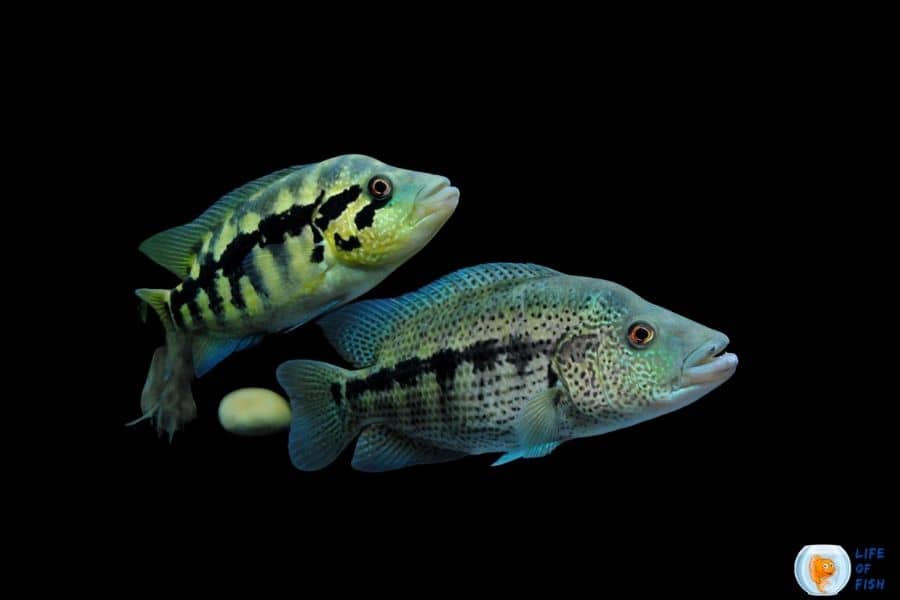
Feeding Schedule For Cichlids
You can follow this table to get knowledge of the food type and feeding frequency.
| Fish Variety | How Often To Feed | Cichlid Foods |
|---|---|---|
| Malawi Cichlids | 2 times per day | Spectrum and Hikari Pellets Spirulina Broccoli Cucumber Peas Lettuce Nori A tiny amount of brine shrimp Prawns Daphnia Mysis shrimp |
| Peacock Cichlids | 2 times per day | Insects Larvae zooplankton Brine shrimps (live or frozen) Daphnia frozen Prepared foods New life spectrum cichlid formula Hikari sinking cichlid gold pellets Omega one freeze-dried brine shrimp Tetra blood worms Hikari bio-pure freeze-dried daphnia |
| Juvenile Cichlids | 2-3 times per day | A mixture of protein-rich foods. Newly hatched brine shrimps Powder fry foods Specialized liquid foods |
| African Cichlids | 2 times per day | Small fish meat Insects Frozen foods Tubifex Worms Wafers Cichlid pellets Brine shrimps Household vegetables and foods |
| Mbuna Cichlids | 2 times per day | Dried seaweeds Plant-based flakes Plant-based pellets Brine shrimps Bloodworms |
| Convict Cichlids | 2 times per day | Pellets – Hikari cichlids gold floating Pellets Frozen foods – blood |
| Electric Blue Cichlid | 1-2 times per day | Try always to give live food. If not, frozen or freeze-dried foods also is okay. Add cichlids pellets as a supplemental food, not as the primary food diet |
| Electric Blue Cichlid | 2 times per day | Cichlid pellets Cichlids flakes Brine shrimp Baby brine Insects Earthworms Crustaceans |
| Electric Blue Cichlid | Breeding period | Earthworms Live black worms Live brine shrimps Cherry shrimp Daphnia |
| Yellow Lab Cichlid | 2 times per day Enhance the color. | Spirulina flakes Goldfish food |
| Yellow Lab Cichlid | Daily basis | Brine shrimps Bloodworms Pellets or flakes containing vegetable matter |
| Oscar Cichlid | 2 times per day | Insects like small crickets Mealworms Fruits, Nuts: peanuts, and other soft nuts Veggies: especially frozen peas Prepared foods: Pellets, Flakes, Wafer Fresh and frozen seafood: Shrimps, clams, scallops and Bloodworms brine shrimp Mysis shrimp |
| Kribensis Cichlid | 2 times per day Main diet | Plant Algae Herbivore flakes and pellets Hikari Sinking Pellets |
| Kribensis Cichlid | Alternatives | Live foods- blackworms, daphnia, brine shrimps Frozen foods – Kribs, blackworms, daphnia, brine shrimps Vegetables- zucchini medallions, shelled peas |
| Frontosa Cichlid | 2 times per day | High protein pellets Flakes Live/frozen foods Shrimps Krill Mysis |
| Jewel Cichlid | 2 times per day | Vegetables including lettuce leaves and spirulina Prepared foods pellets and flakes Bloodworms White worms Fish frames Tubifex |
| Venustus Cichlid | 2 times per day | High-quality pellets and flakes containing vegetable matters Brine shrimps Bloodworms Small fish |
| Firemouth Cichlid | 2 times per day | High-quality pellets and flakes Vegetables: spinach, spirulina Meaty supplements: bloodworms, brine shrimps |
| Jack Dempsey cichlid | 1-2 times per day | Prepared foods- pellets and flakes Frozen foods – bloodworms, tubifex, ocean plankton Live fish |
How Long Can A Cichlid Go Without Eating?
Healthy cichlid can survive around 7 to 10 days without food. But this estimated time can vary with several factors. These are:
Age of the Cichlid fish
Size of the Cichlid fish
Where cichlid is carnivore or herbivore
Large and older fish can go longer without food than younger and small Cichlids. Because large and old cichlids have more fat reserves and body mass. But try to feed your fish regularly to keep them happy.
Why Are My Cichlids Always Hungry?
Cichlids are aggressive eaters. When you go near the Cichlid tank, they always behave as hungry. But, if you feed them adequately, you do not need to worry about these behaviors. Hence, extra feeding is a reason to overfeed your cichlid. Further, cichlid fish do not have an idea about sufficient food amount enough for them to survive.
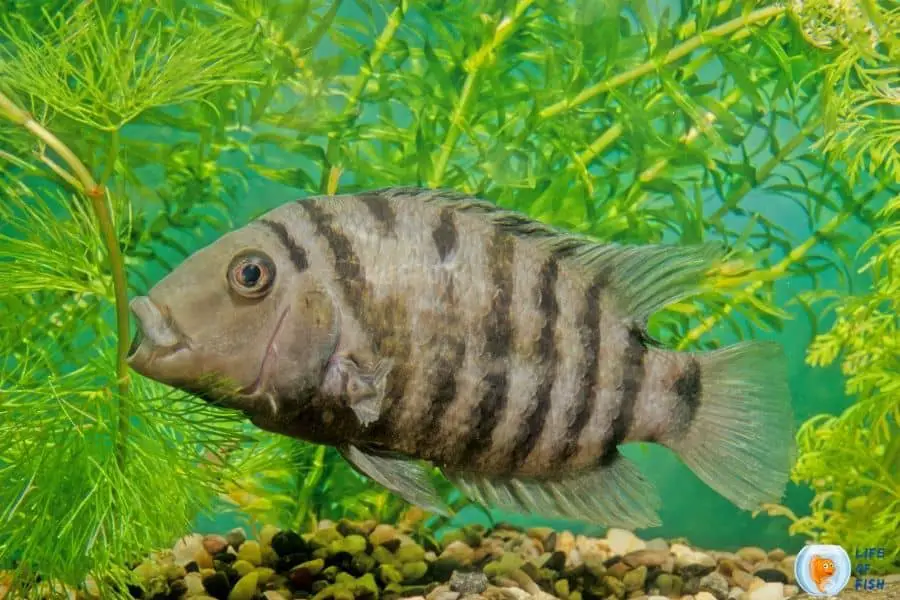
What Happens If You Overfeed Cichlids?
When you rear any fish, including cichlids, overfeeding is not a good thing. Overfeeding can generate harmful impacts on your Cichlids.
Health problems
Overfeeding and health problems have come together. Moreover, fatty liver or hepatic lipidosis is a common disease that can be found among African cichlids. Also, the leading cause of this disease is overfeeding. Further, this fatty liver disease directly affects the function of the fish's liver, and eventually, it can kill your cichlid.
High ammonia and nitrate level
The uneaten fish foods and a large amount of fecal matter can increase the ammonia, nitrite, and nitrate in the water. Also, these are toxic to the fish, including cichlids. Further, protein-rich uneaten food can quickly deteriorate water quality by breakdown into the above toxic substances.
Low pH level
Decaying organic materials such as fish wastes and excess foods produce acidic compounds. It causes a lower pH level in aquarium water.
Lower oxygen levels
The uneaten foods and fish fecal matter are decaying in aerobic processes. As a result of the aerobic reaction, it consumes oxygen and produces carbon dioxide. Therefore, it reduces the dissolved oxygen in the tank water.
Cloudy water
Cloudy water is a result of decaying uneaten foods and fish wastes. Moreover, fish hobbyists love to maintain their aquarium crystal clear. But excess food can destroy their dream.
Planaria or flatworms
Excess feeding may generate more fecal matter too. Moreover, the massive amount of fecal matter cannot be filtered through the filter system. Then it deteriorates the water quality. Also, these worms will generate because of poor water quality. Thus, you should properly maintain the water quality to eliminate unwanted pests.
Algae bloom
Overfeeding is the primary reason to grow algae in the aquarium. Also, the excess feed may generate excess fish waste and uneaten food waste. Then algae can grow fastly when water is rich in nutrients. Thus, do not allow the extra food to remain in the tank.
Mold
Mold or fungus also grows due to high levels of organic material in tank water.
Related: Blue Texas Cichlid Care And 12 Things Must Know
Related: Koi Angelfish | Care Guide & 15 Things Must Know
Why Cichlids Not Eating
Several reasons can cause a lack of appetite for cichlid fish. These are;
- Diseases and poor health
The general diseases of cichlids are swim bladder disease, cichlid bloat, and cotton wool disease. Furthermore, the hole in the head, Ich, and tuberculosis are also common in these fish.
- Poor water quality
- Low water temperature
- Overfeeding
- Stress and unhappiness
- Wrong food
- Fish age: old
- Picky fish
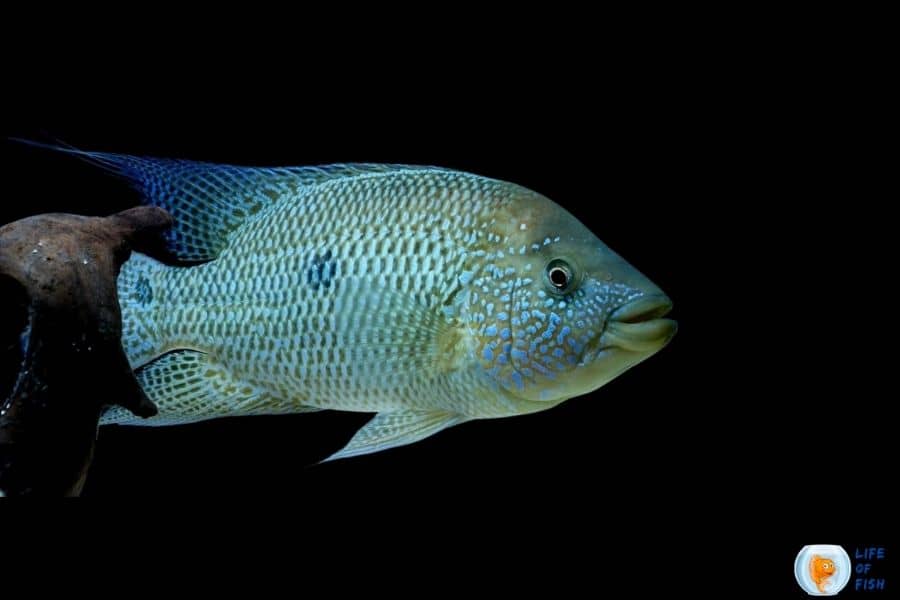
Feeding Malawi Cichlids
Malawi Cichlid usually eats algae on the rocks in their living habitat. Therefore, you can provide these foods to your Malawi Cichlids. Generally, pellet foods can be used easily. Therefore, you can give Life spectrum pellets or Hikari pellets for fish. Further, Malawi cichlids also like to eat spirulina. You can purchase spirulina pellets or flakes at the market. Moreover, use this herbivore food type 1-2 times per week.
But do not let Malawi fish eat a lot of spirulina because it causes black spots on the cichlid body. Further, it will damage the appearance of the fish. You can also give home-based foods to Malawi cichlids such as broccoli, cucumber, peas, lettuce, and nori. Furthermore, you can use meaty foods and live foods to feed Malawi fish, such as daphnia, brine shrimps, and Mysis. However, you can feed Malawi cichlid twice daily, usually morning and night or evening.
Conclusion
The cichlid fish have various diet patterns. Also, according to the diet pattern, they can be categorized as carnivores, omnivores, and herbivores. Hence, you should identify the certain diet behavior of your cichlids before selecting the food. Further, adding enough food is important to keep healthy fish. Hence, please follow the above guidelines to be a proud cichlid owner.
Related: 8 Non Aggressive Cichlids for Community Tank And Care
Related: Red Texas Cichlid Care & 15 Things To Know
Source
Reinthal, P.N., 1990. The feeding habits of a group of herbivorous rock-dwelling cichlid fishes (Cichlidae: Perciformes) from Lake Malawi, Africa. Environmental Biology of Fishes, 27(3), pp.215-233.
piercetherroys1972.blogspot.com
Source: https://lifeoffish.com/how-often-to-feed-cichlids-cichlid-feeding-guide-everything-to-know/
0 Response to "Can I Feed My Ciclhids Catfood"
Post a Comment